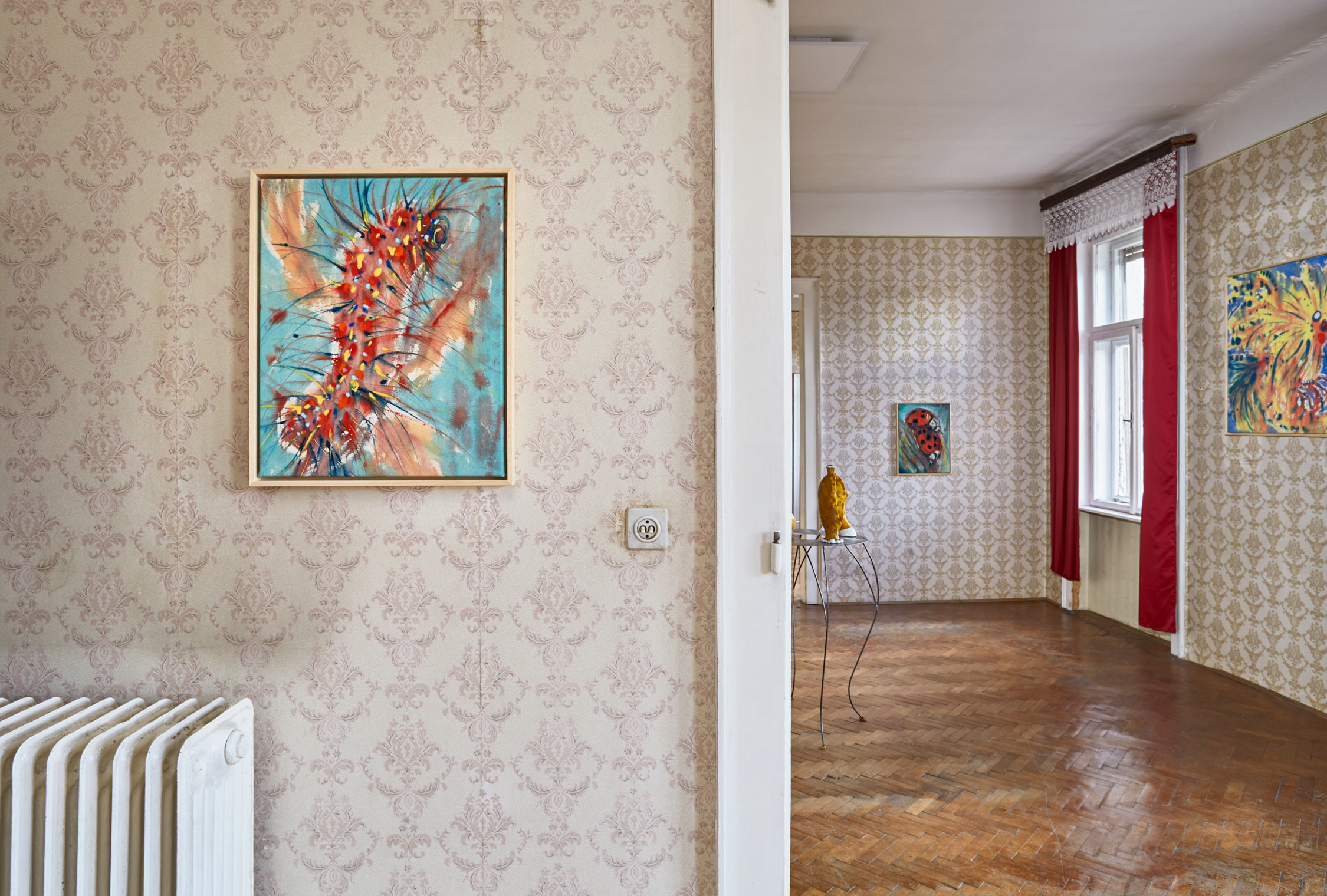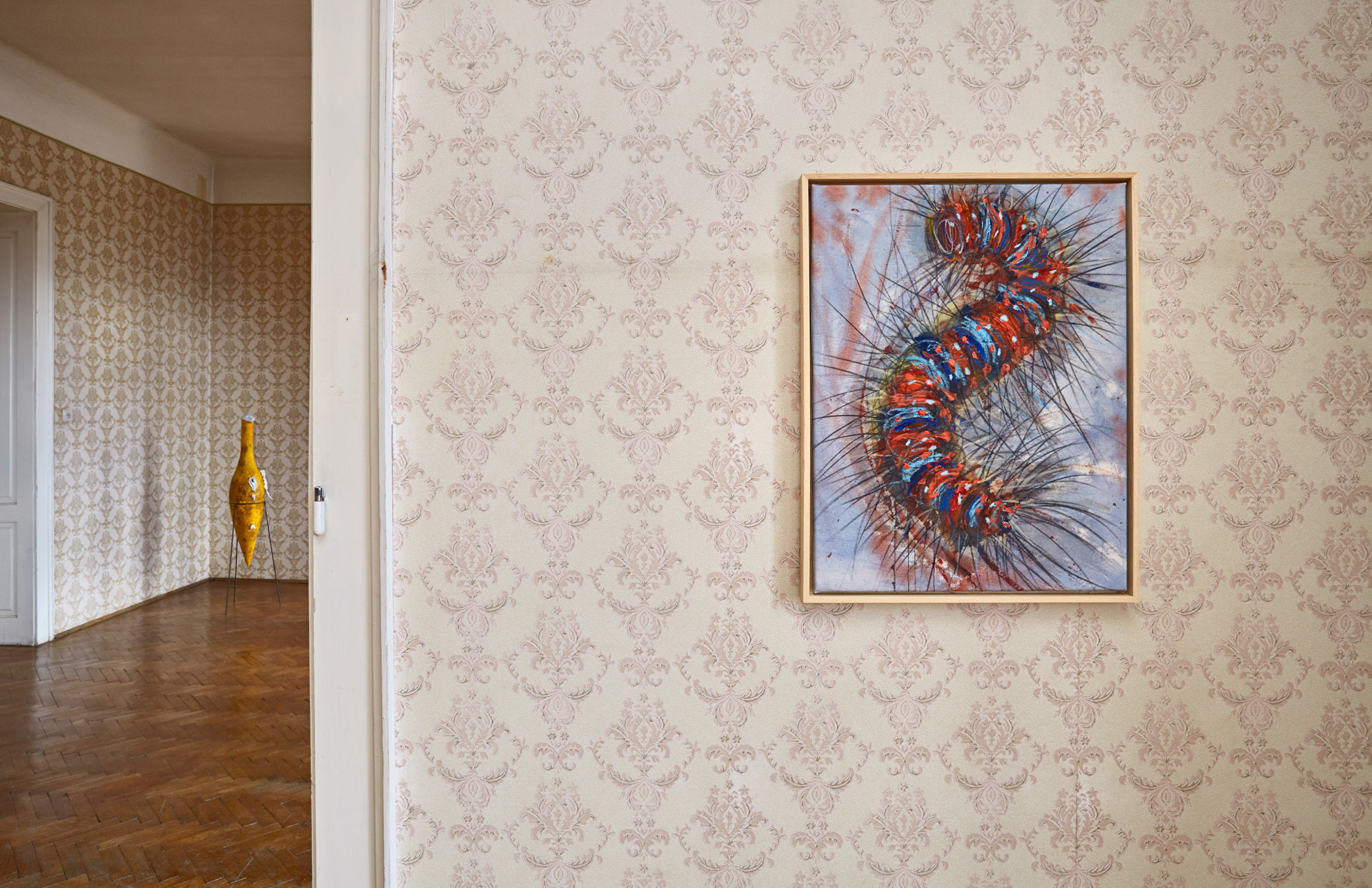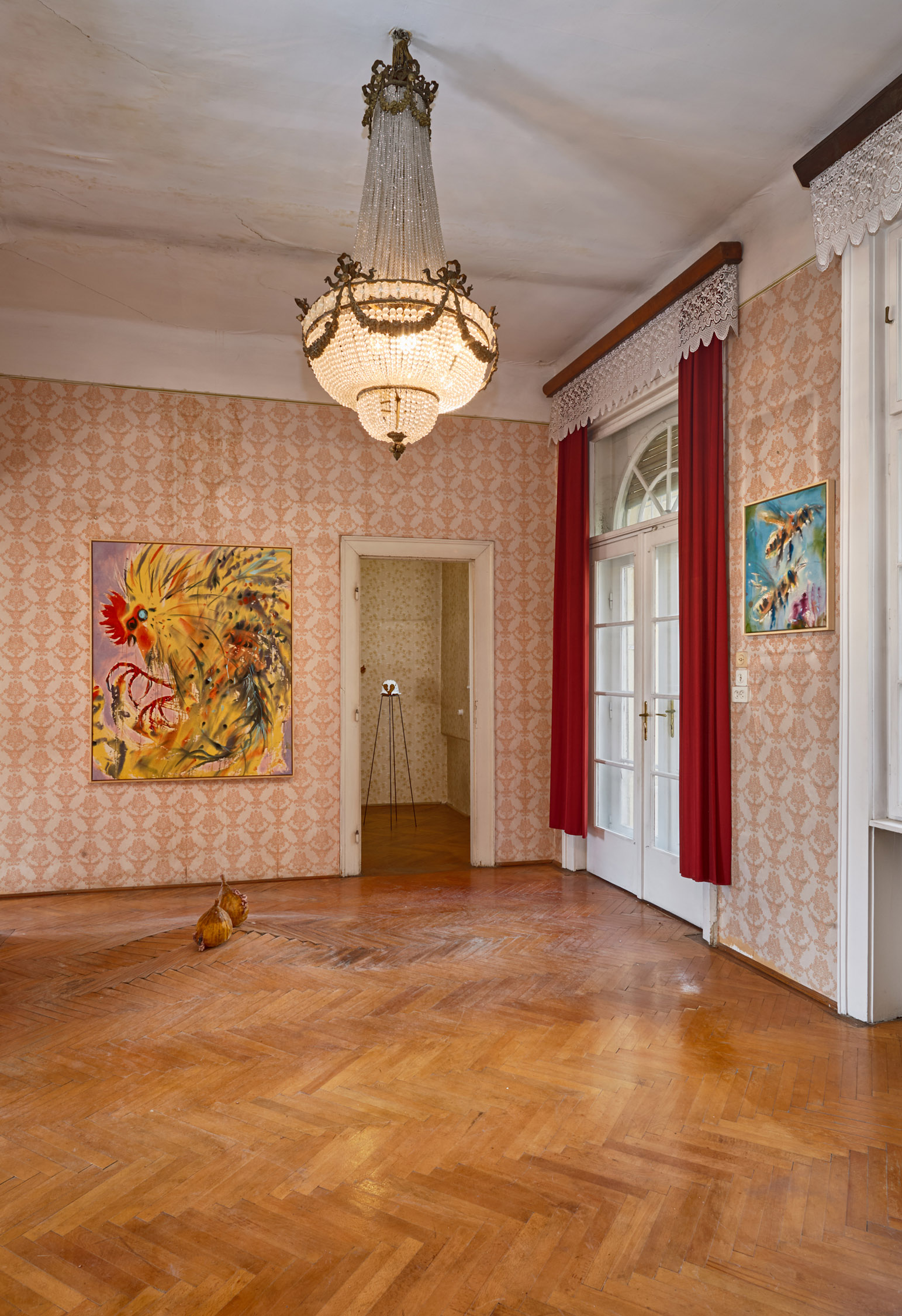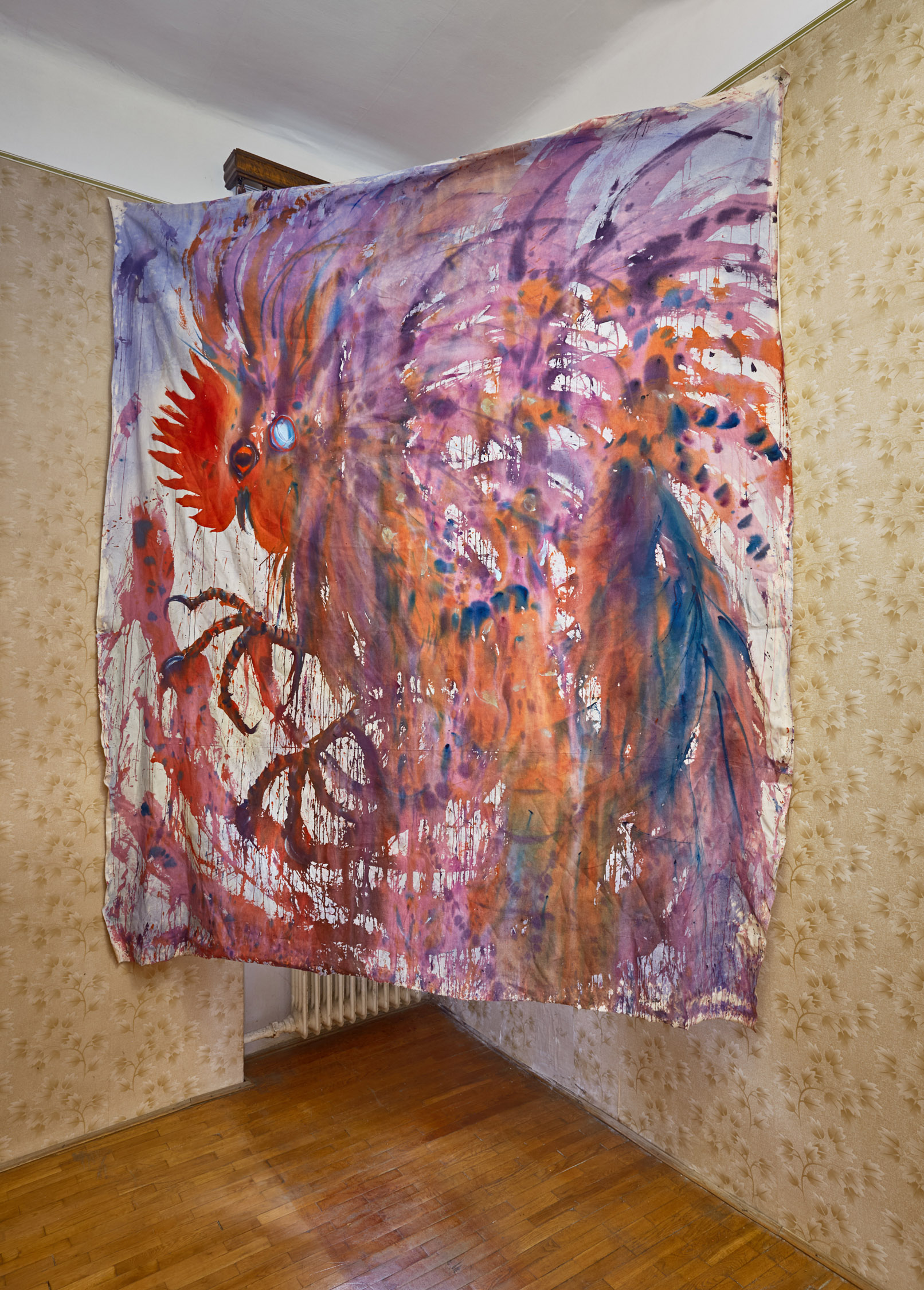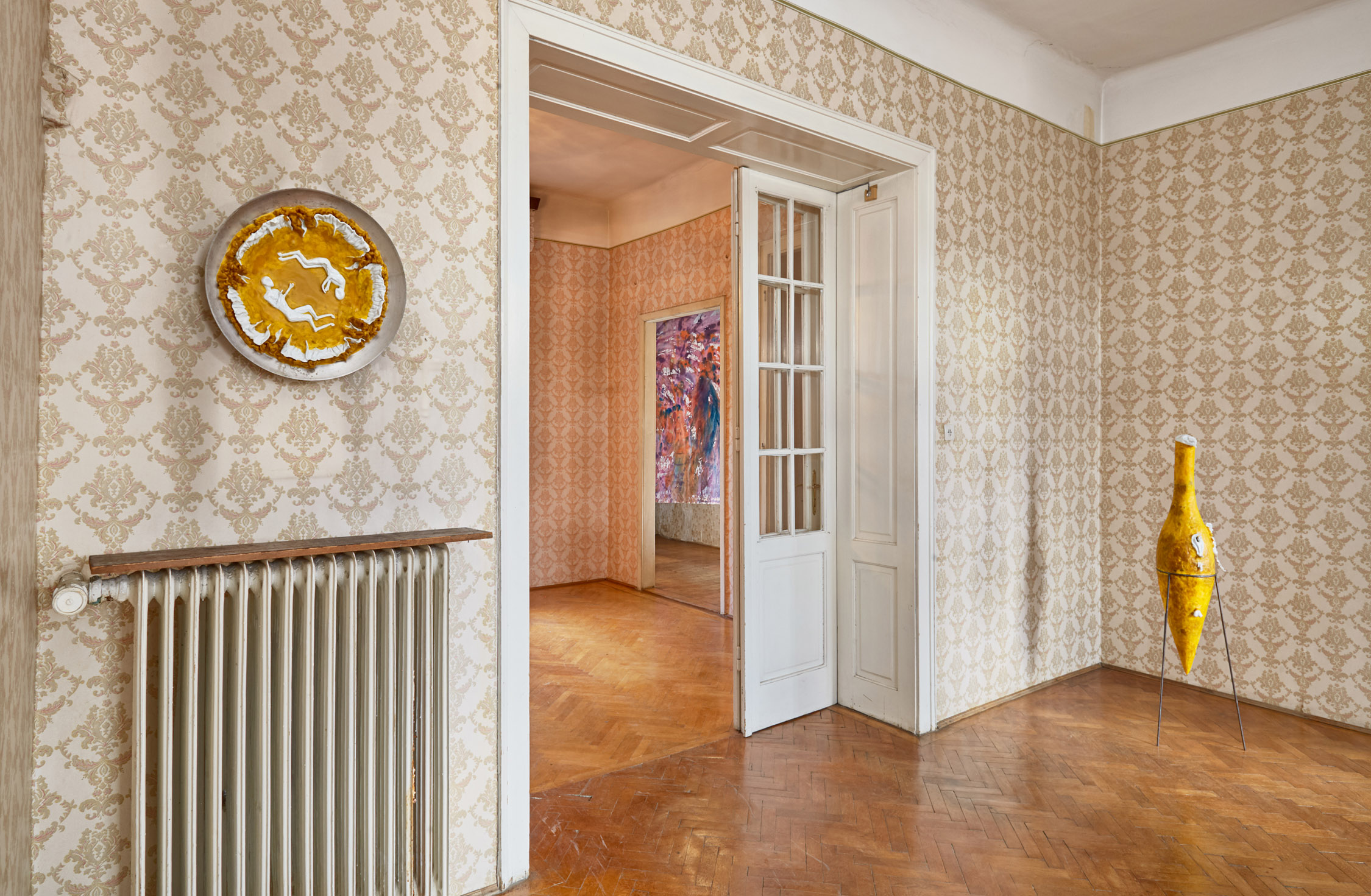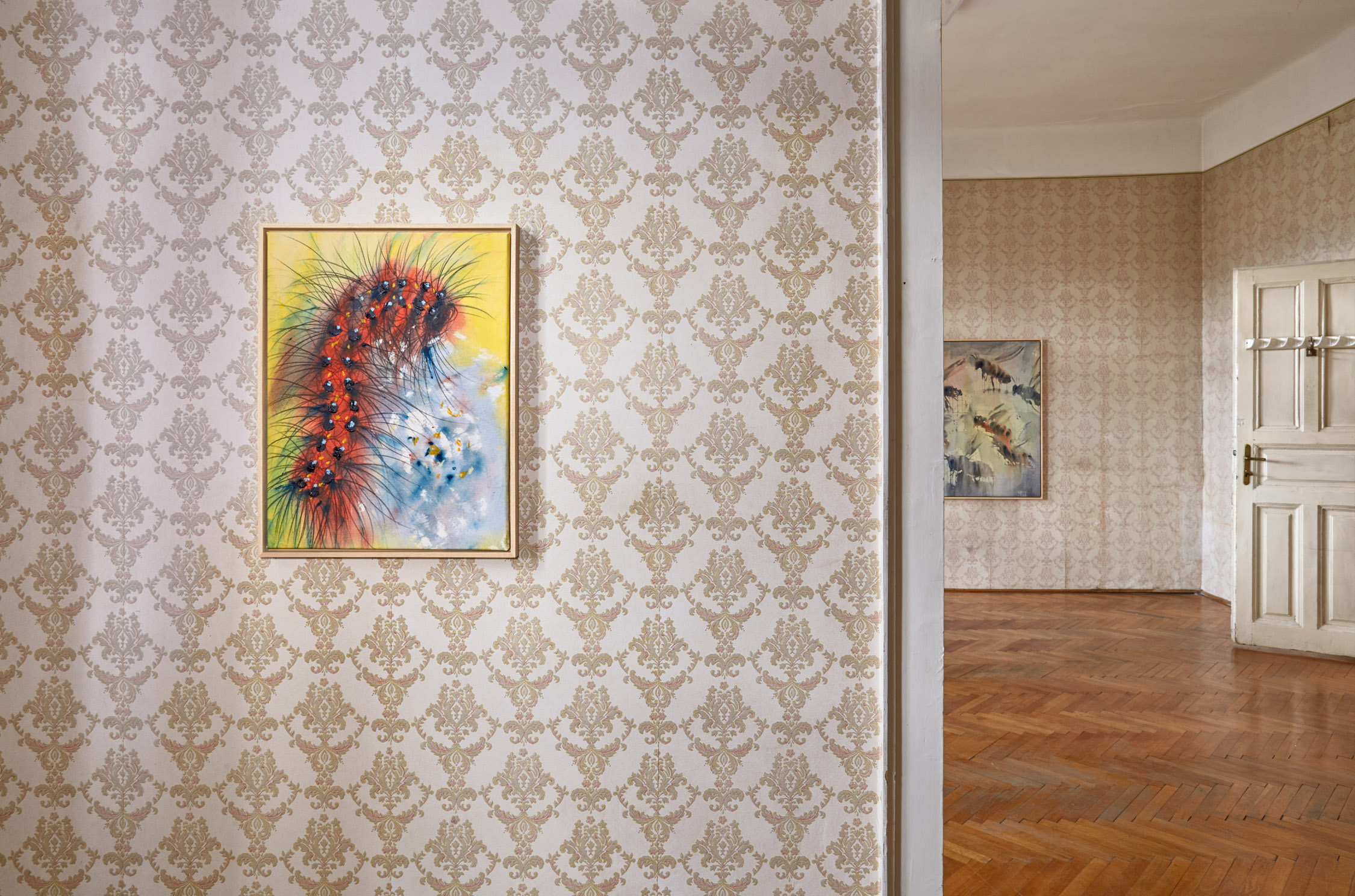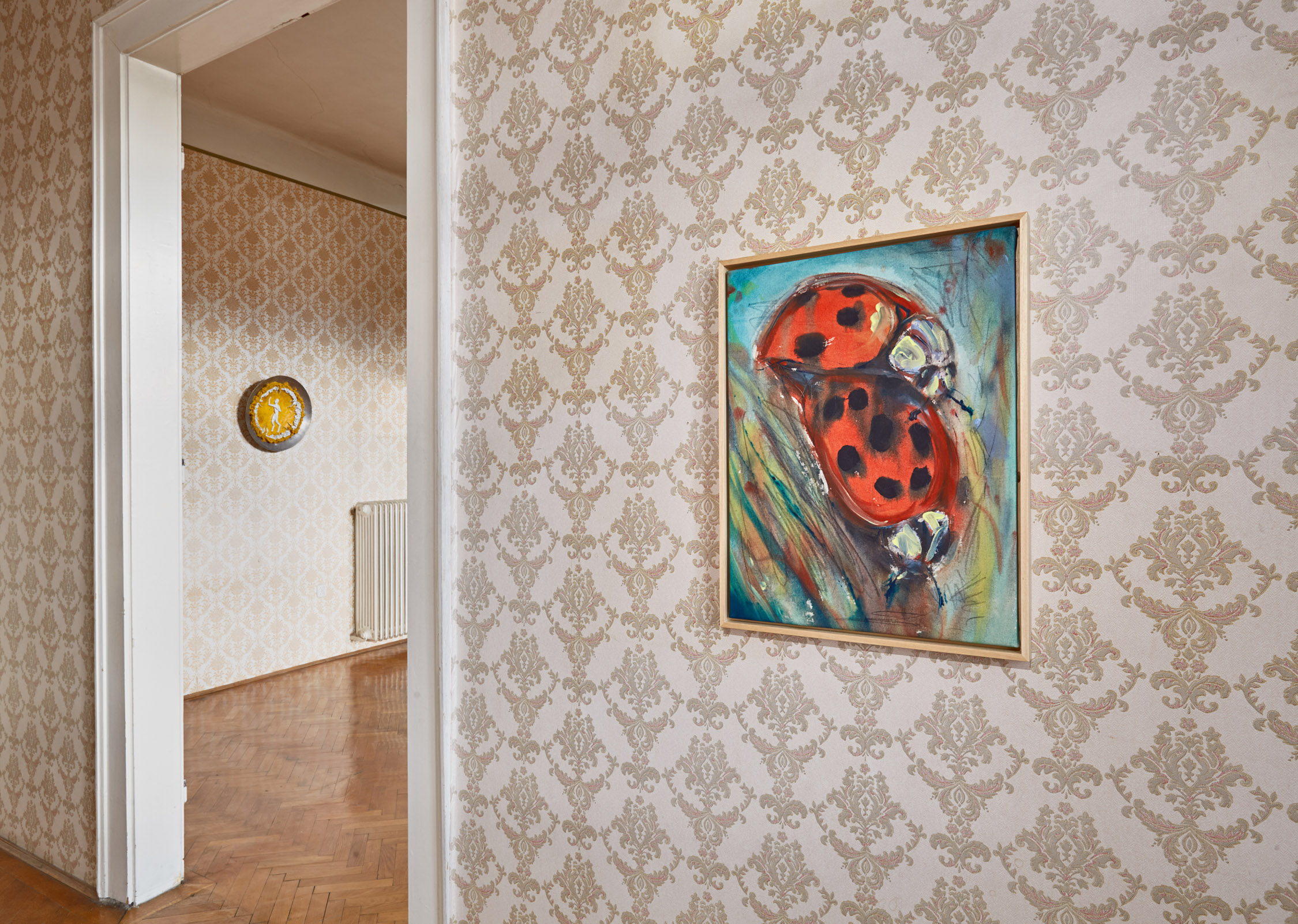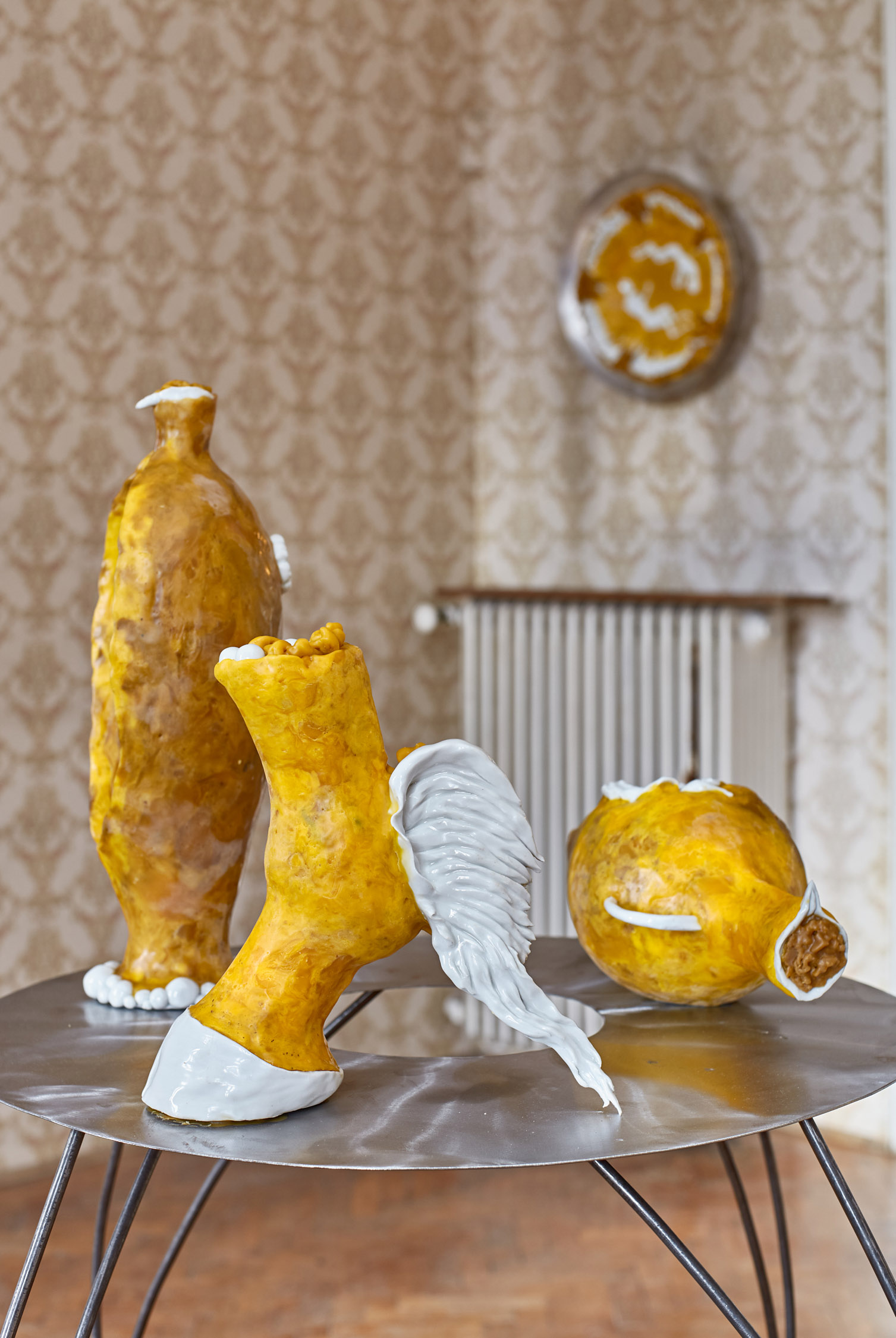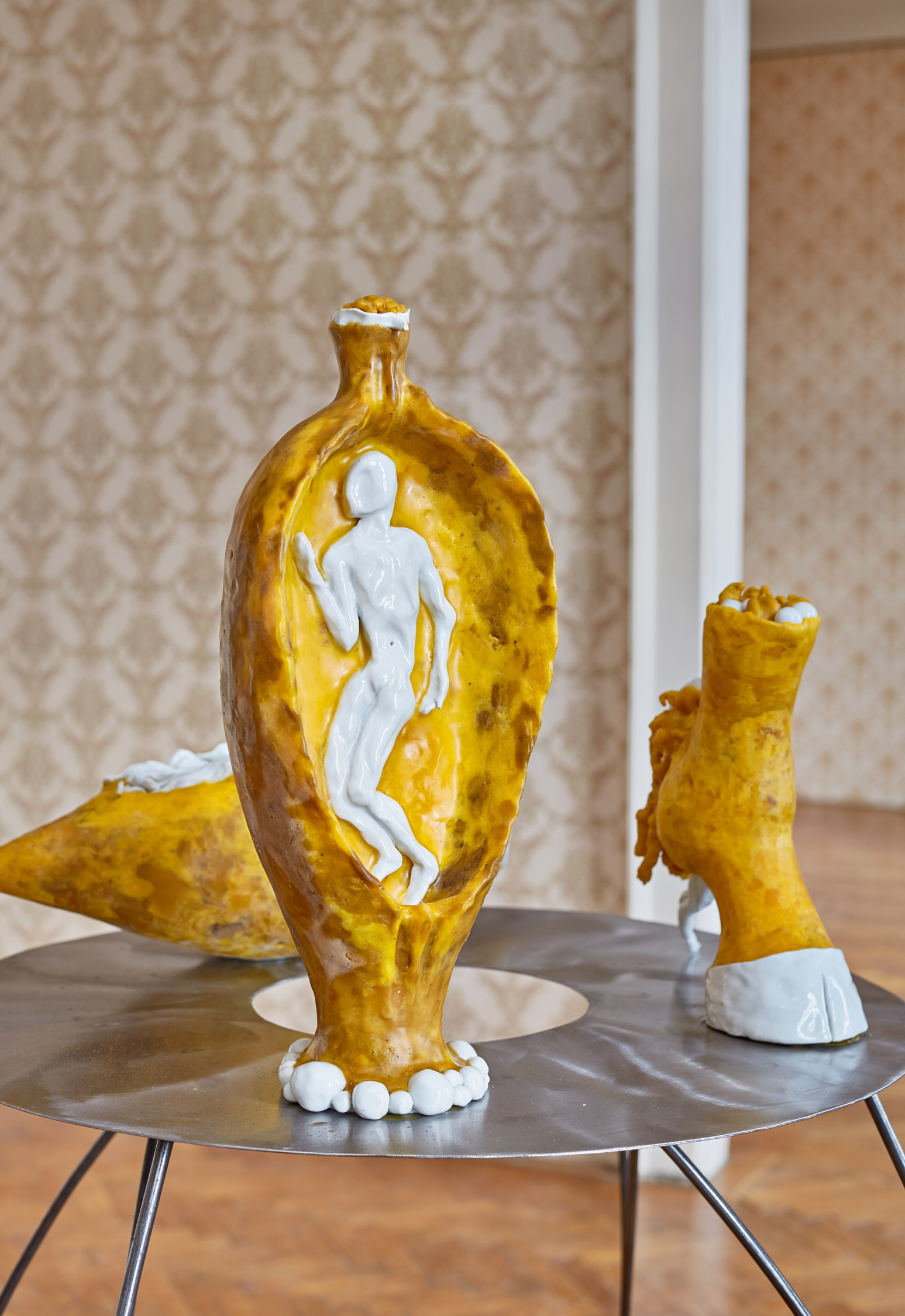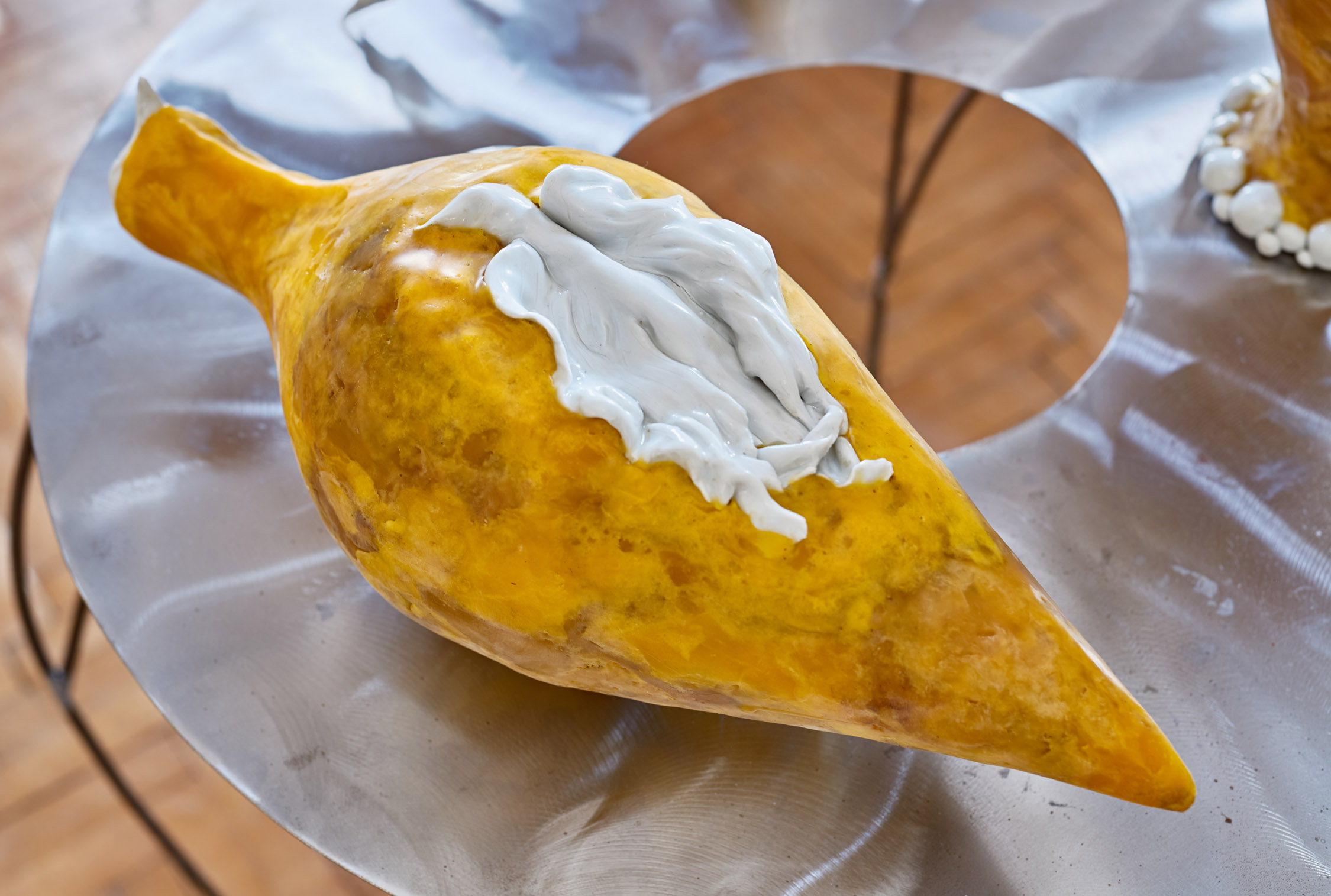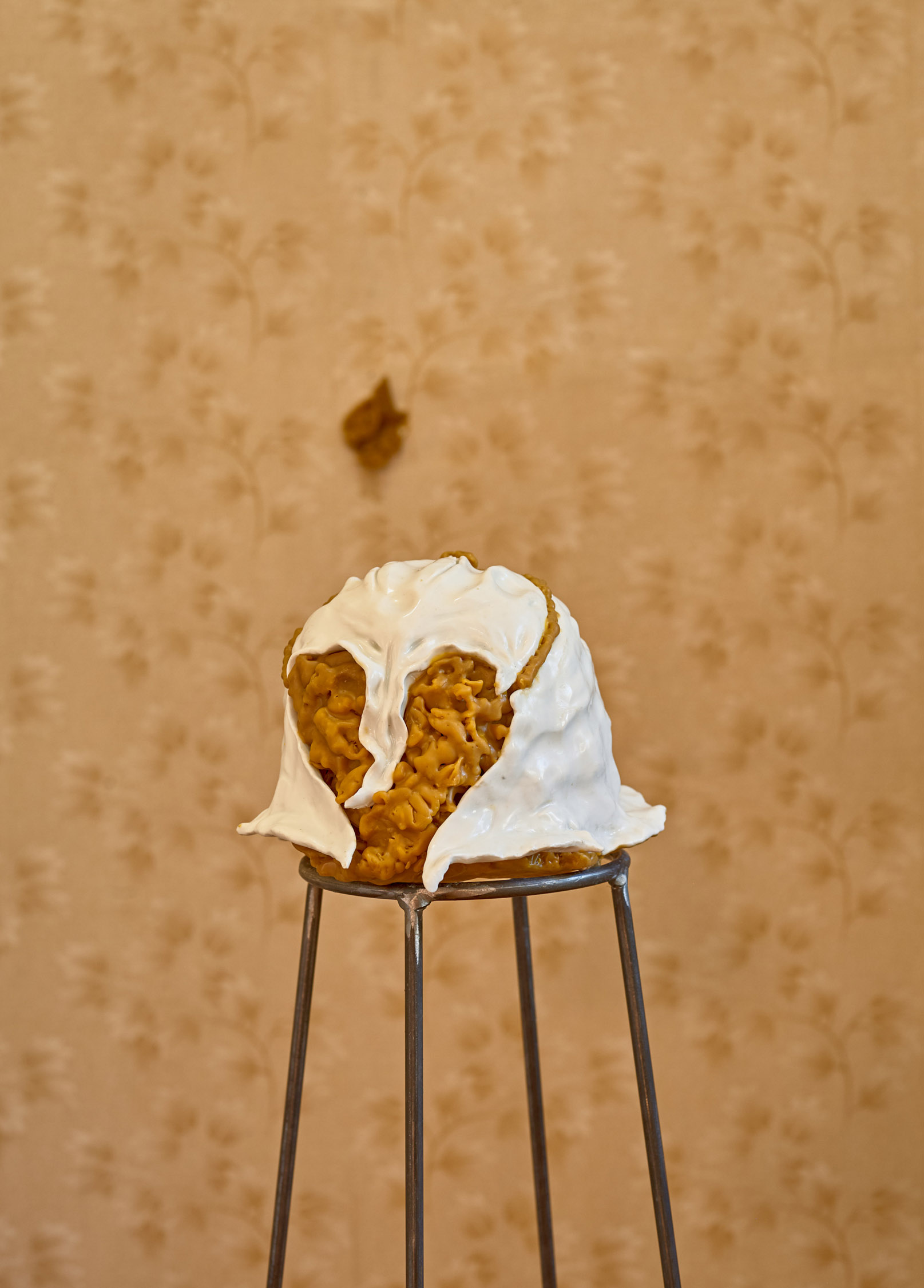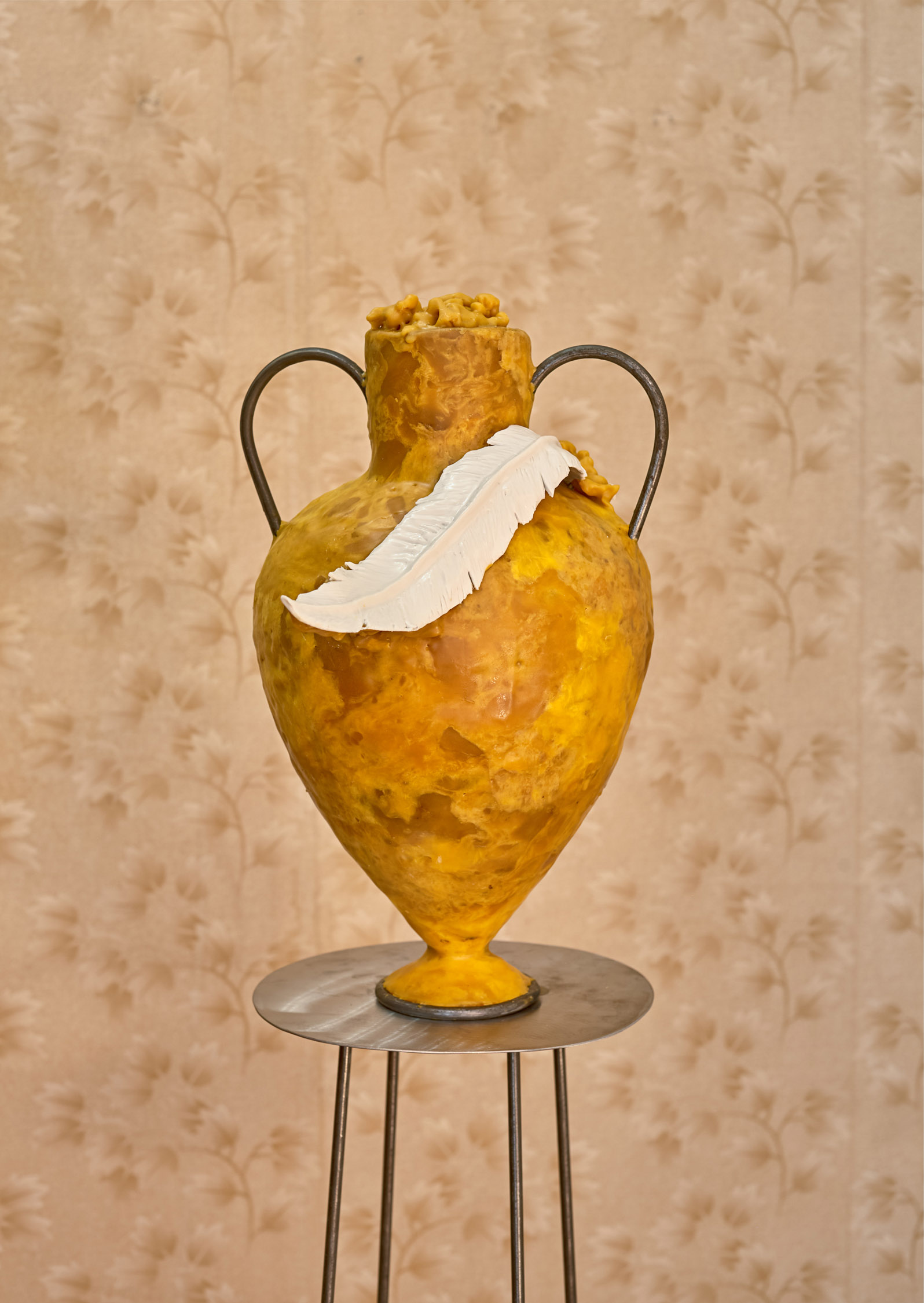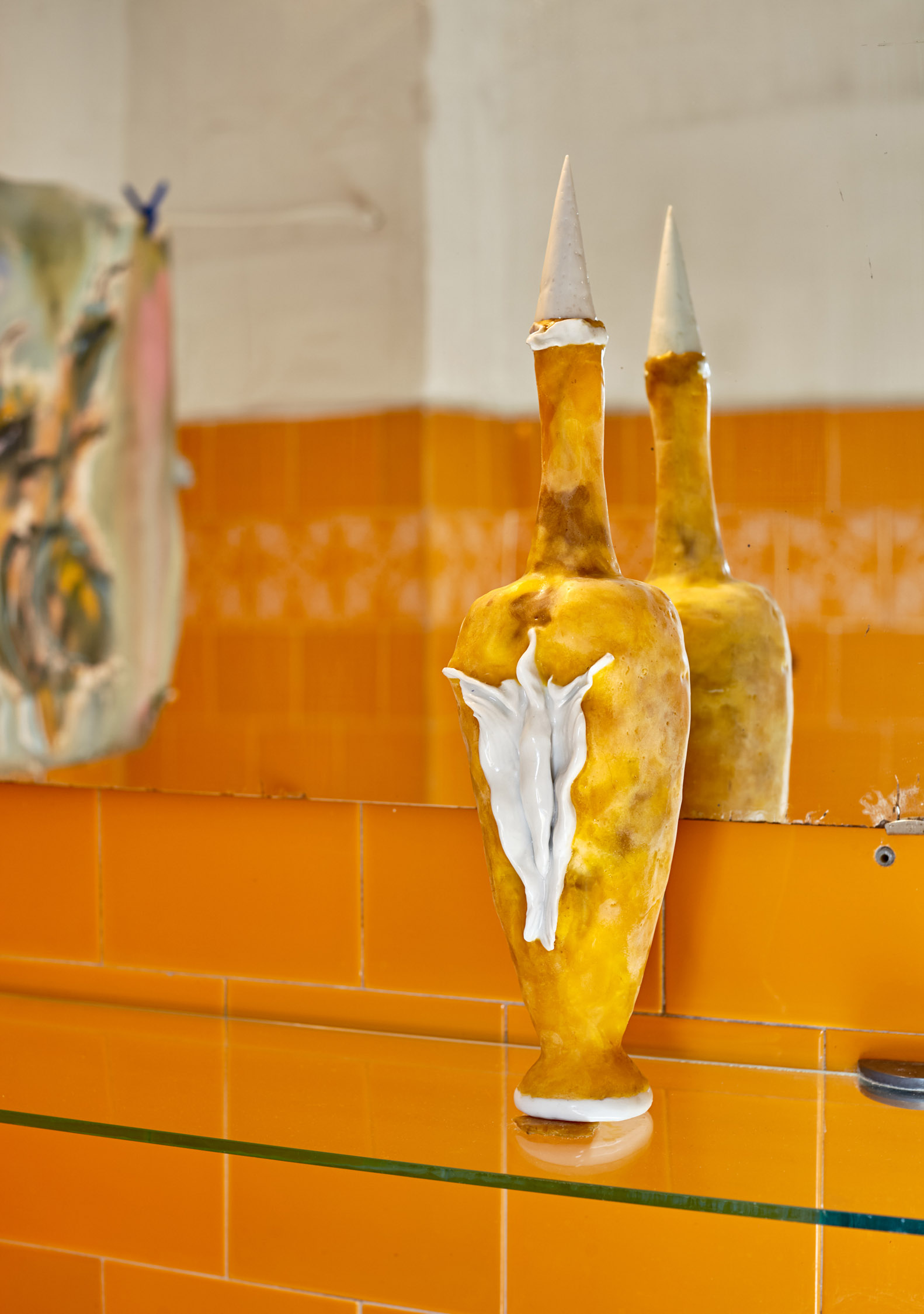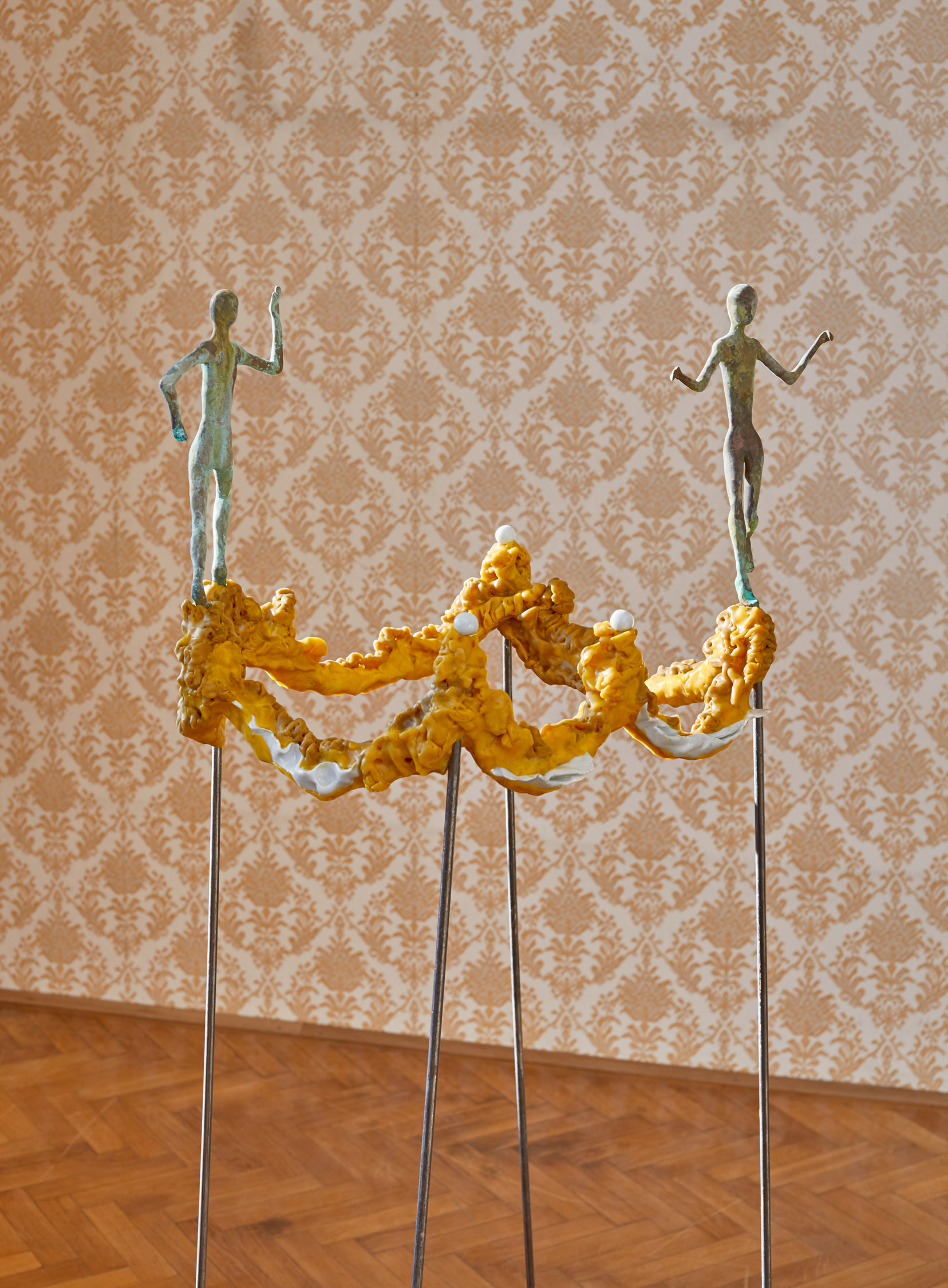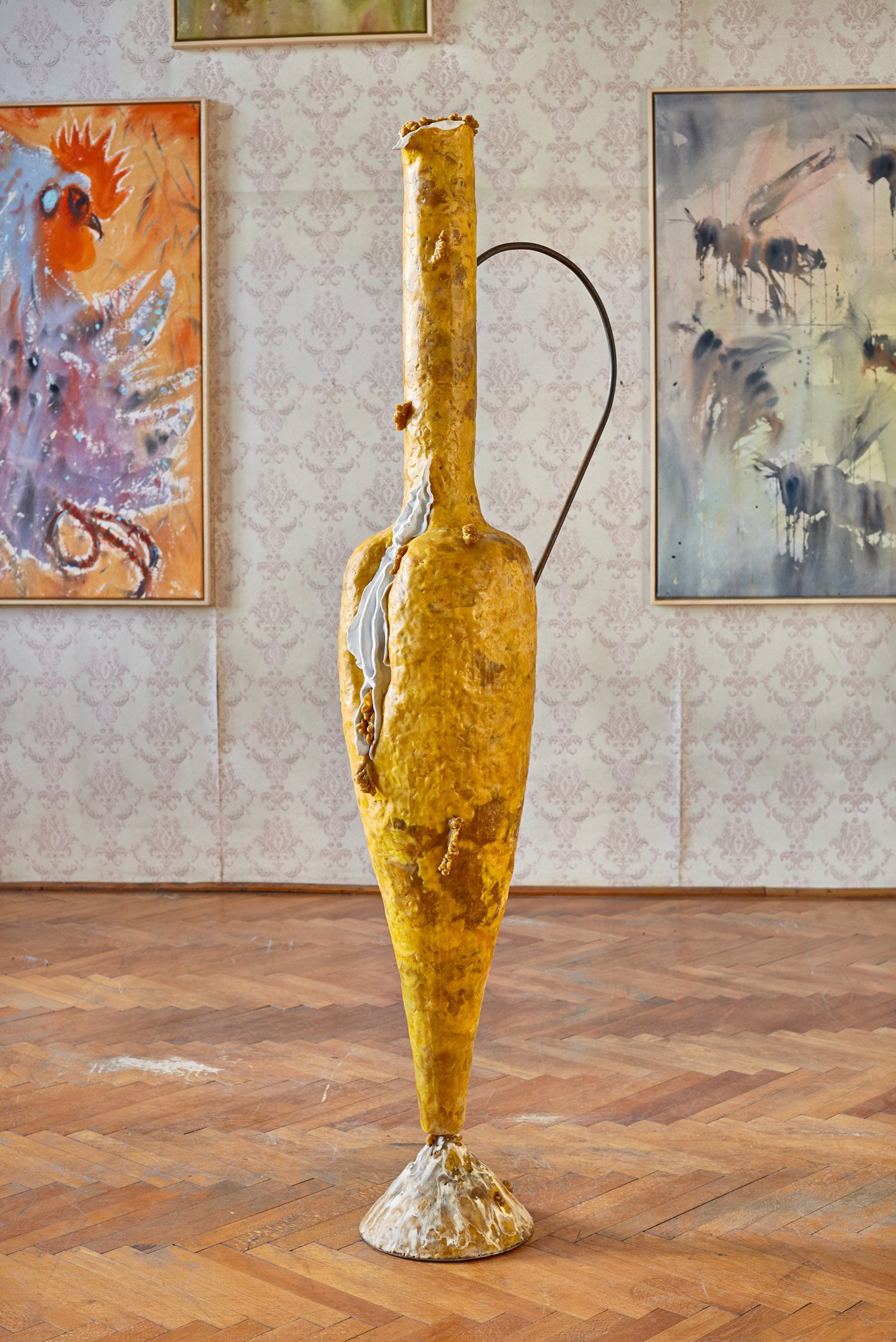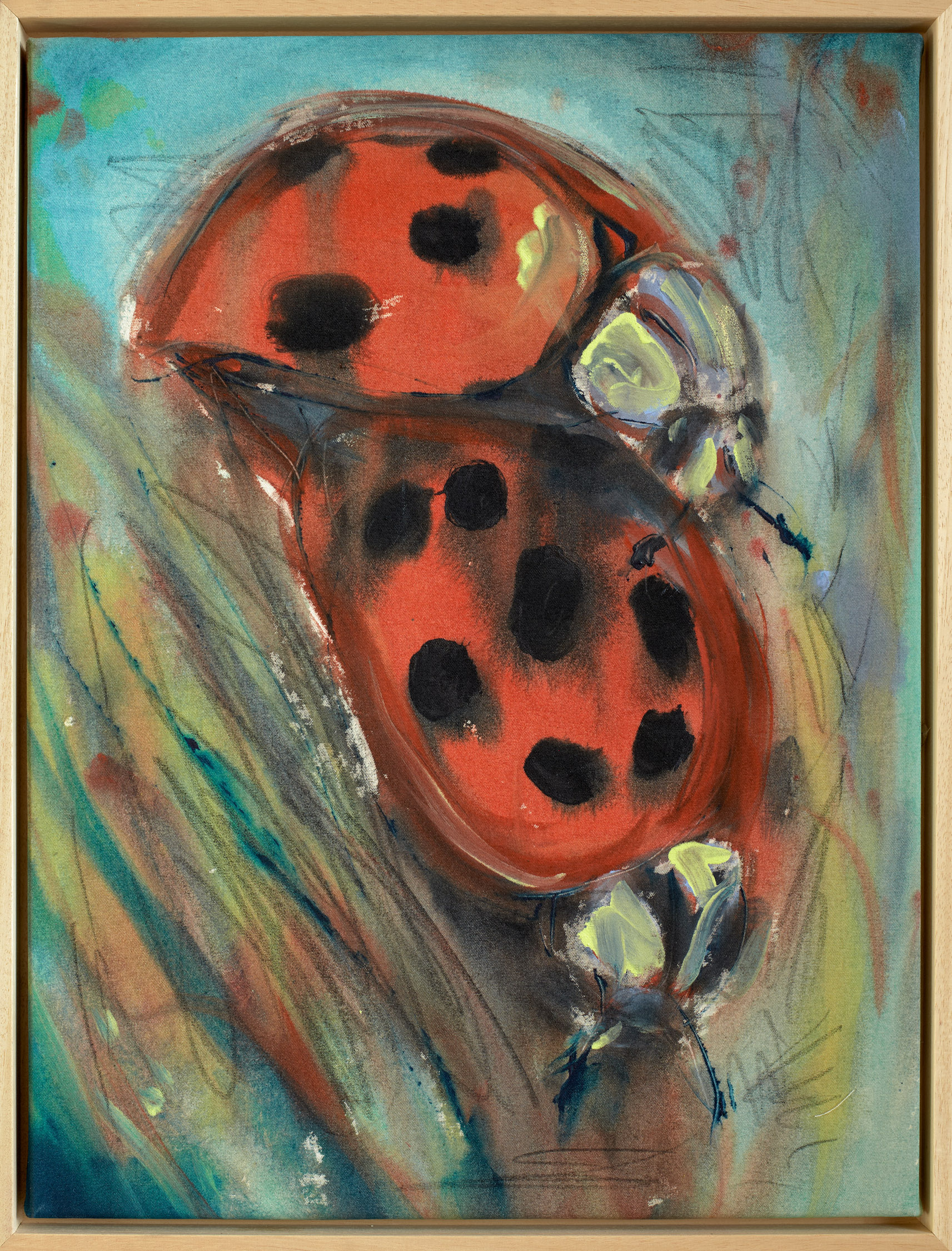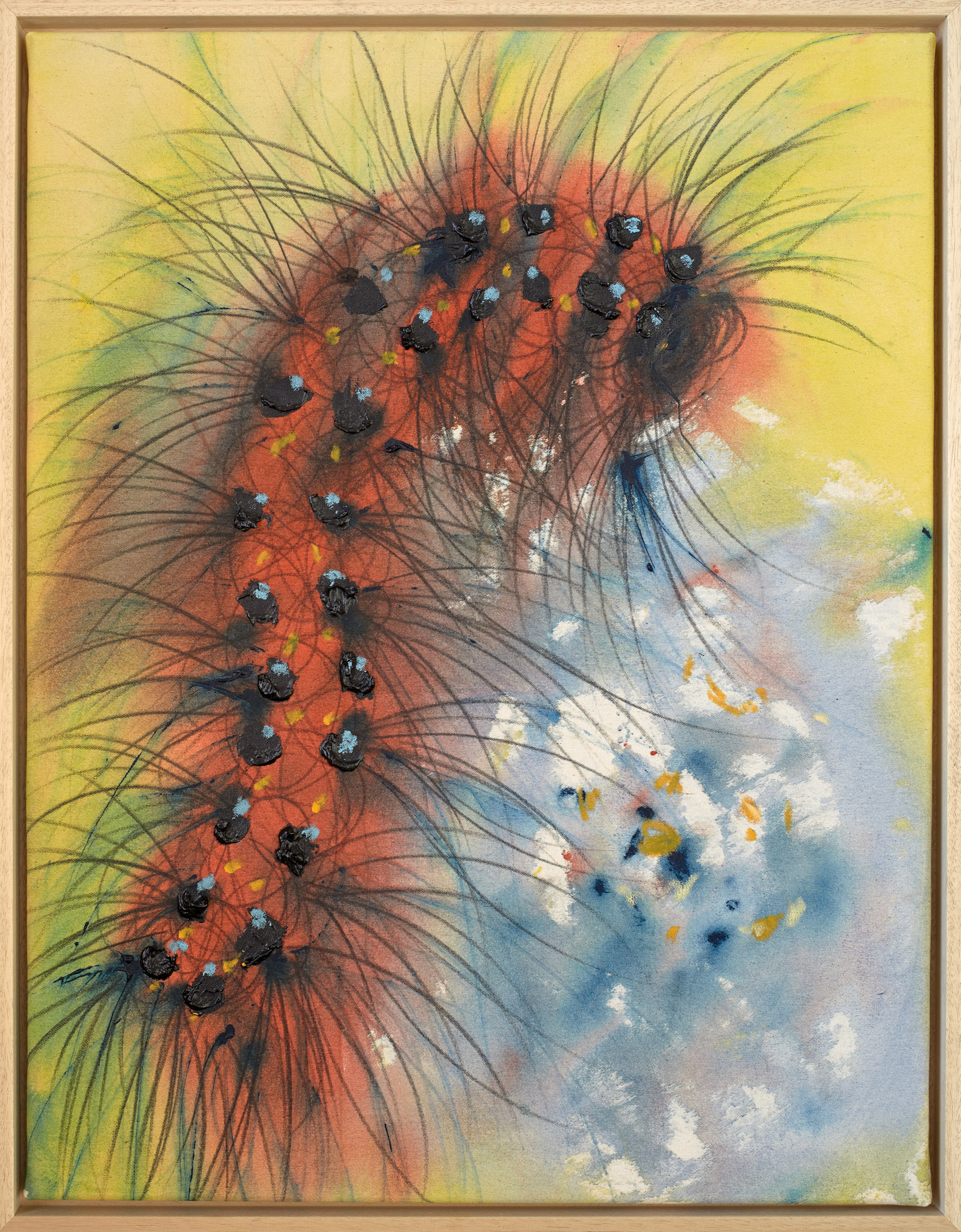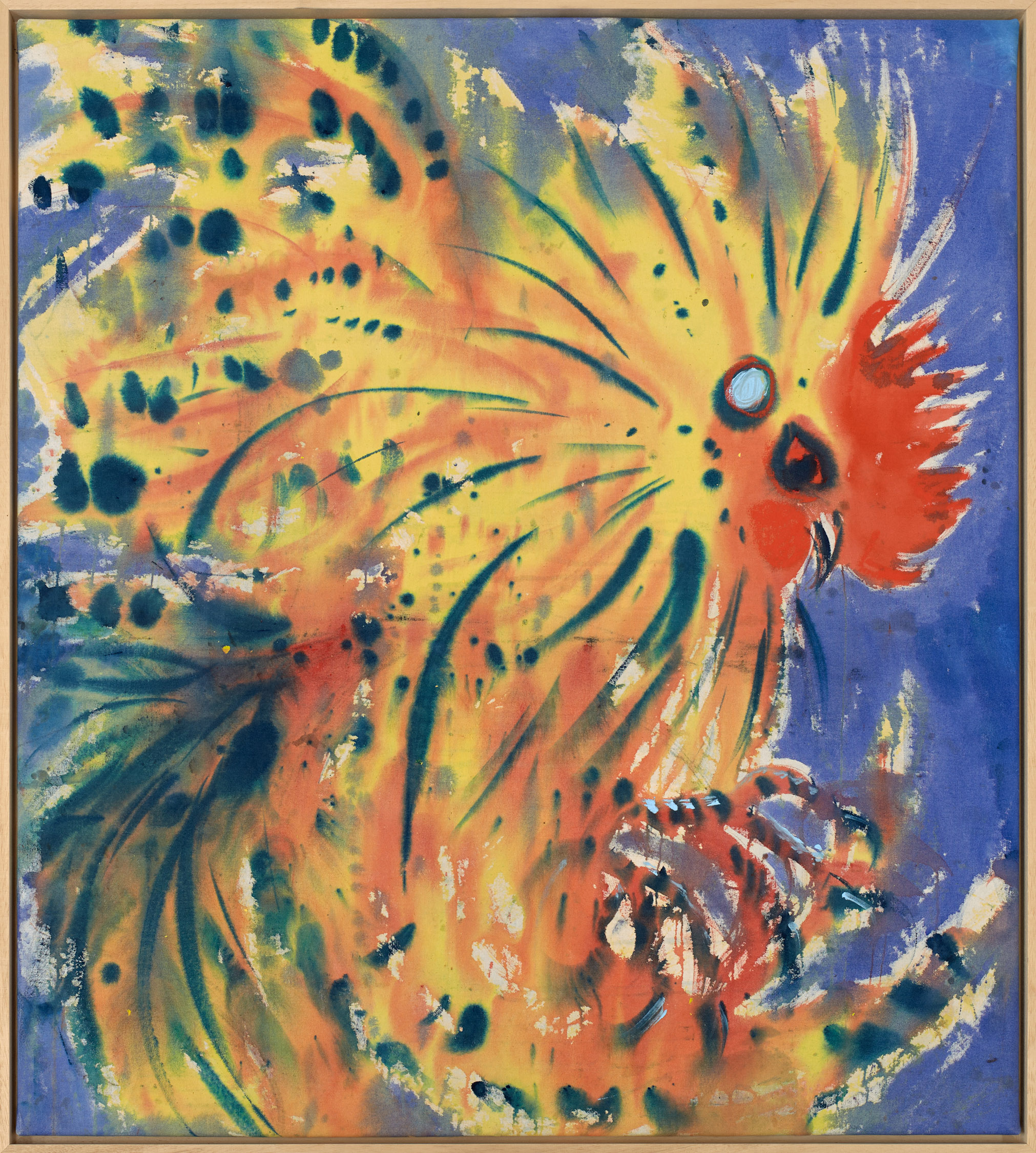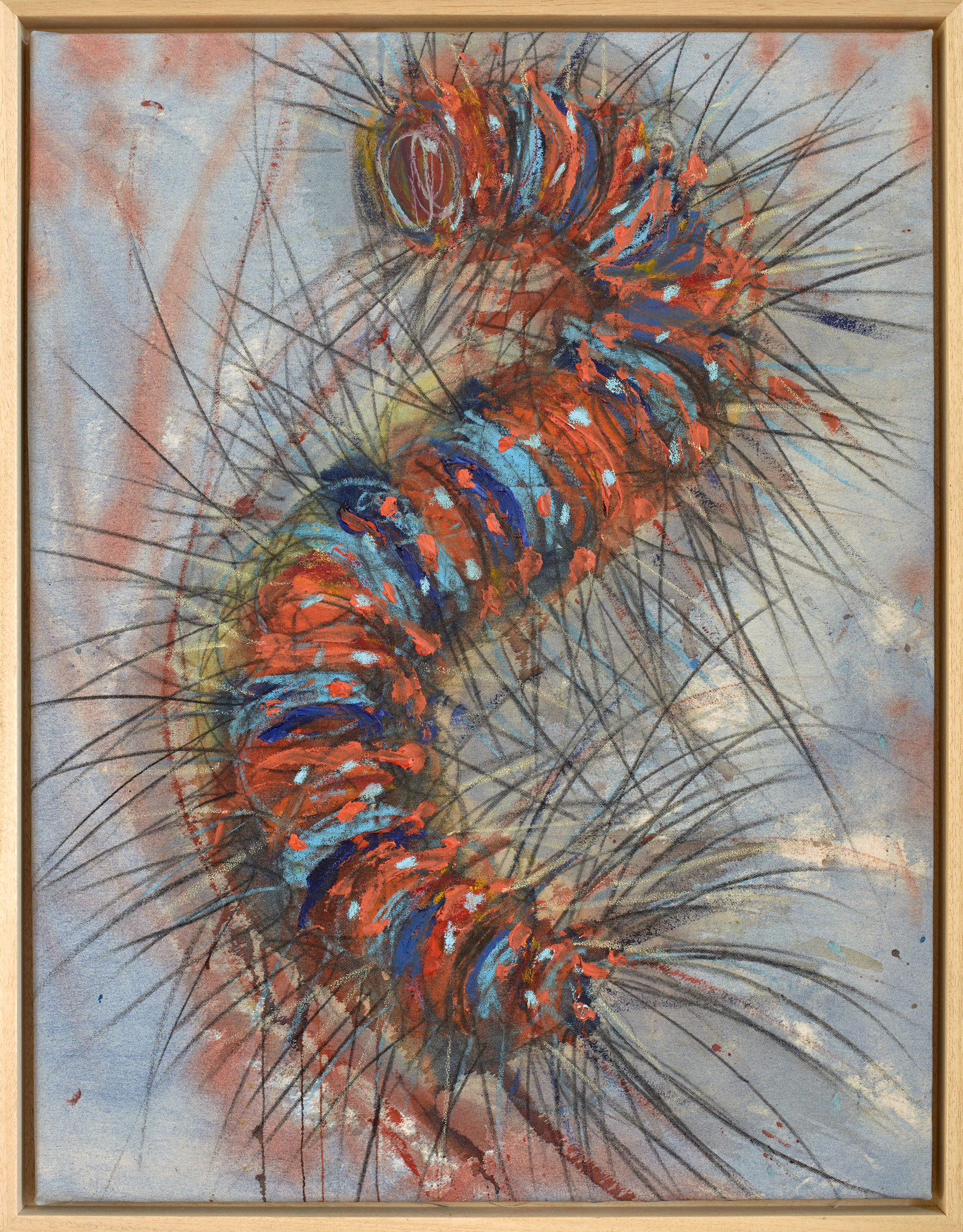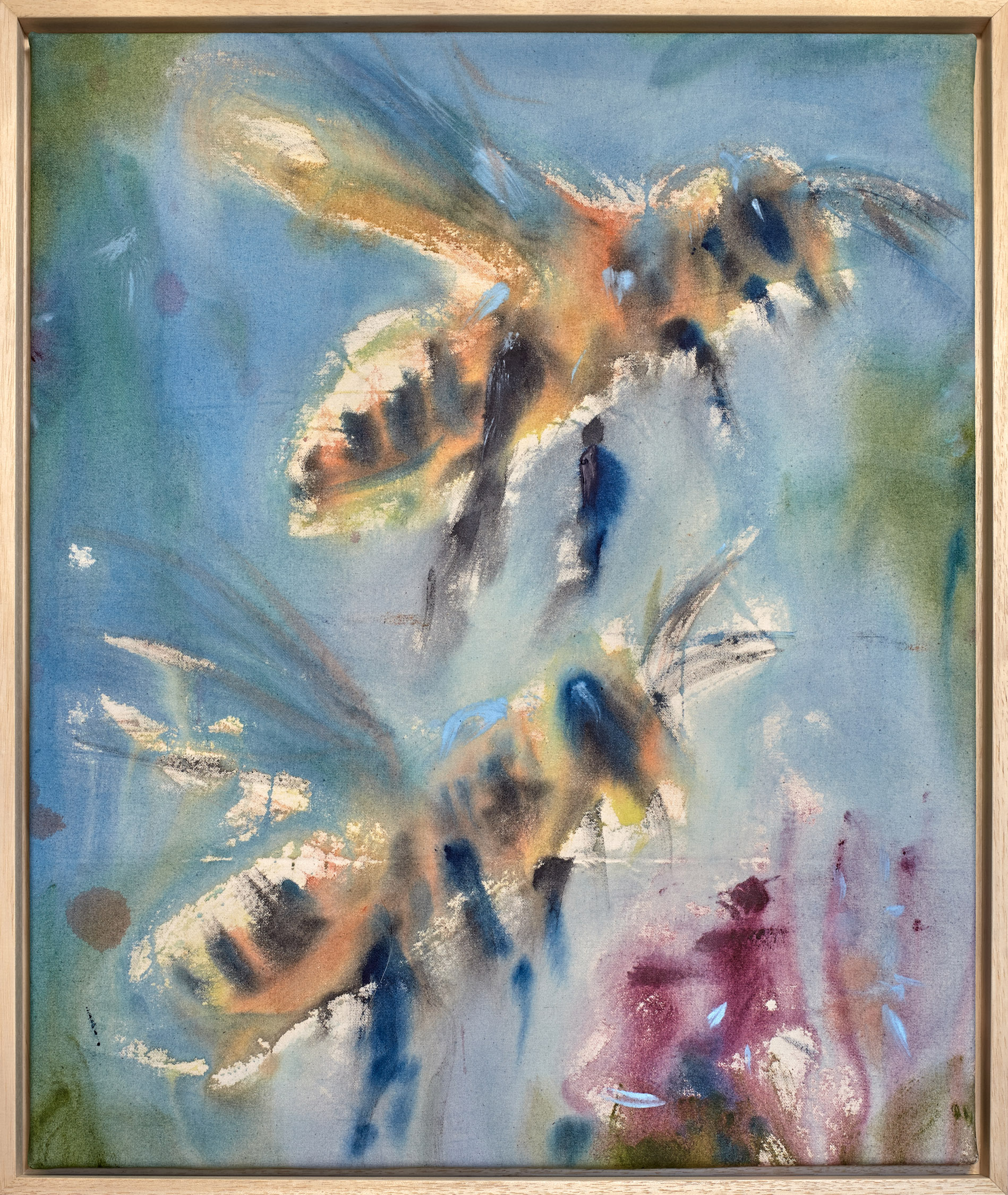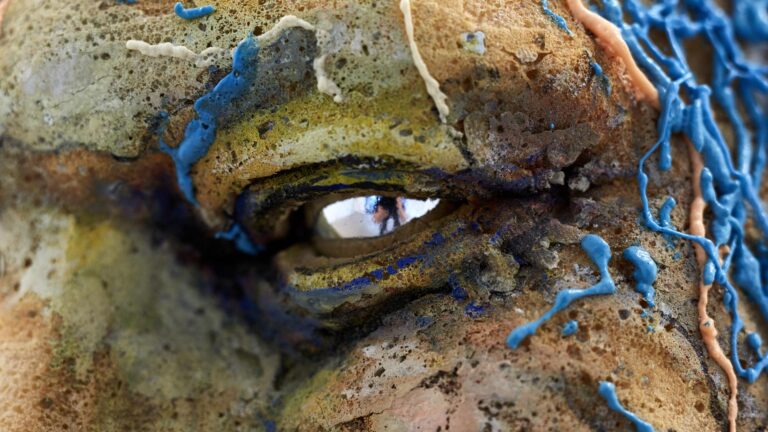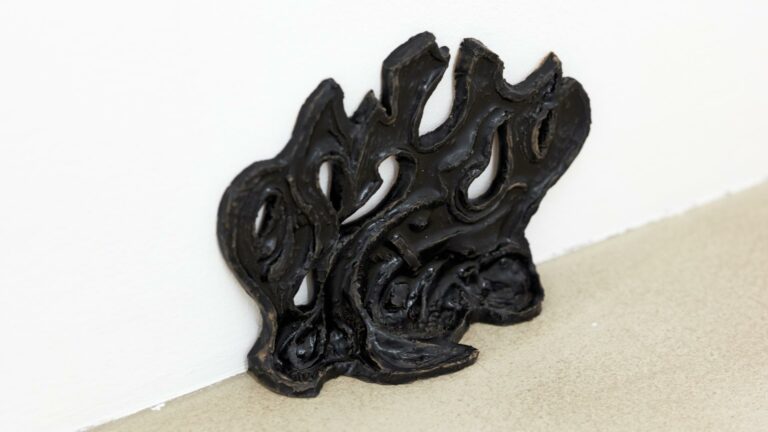Artists: Andrej Dubravsky and Gideon Horváth
Exhibition title: Pollinating Agents
Curated by: Peter Bencze
Venue: Longtermhandstand, Budapest, Hungary
Date: March 27 – May 21, 2024
Photography: Áron Weber / All images copyright and courtesy of the artists and Longtermhandstand
I’ve been looking for Narcissus, but all I can find are horny insects sticking in clumps to the dirty paint rag. Their tiger-striped, hairy abdomens rubbing against each other. Each painting is a self-portrait. In the hum and buzz of spring, the drone throws himself at the mother queen who gives life to generations of larvae. In defiance of court etiquette, he has insolently raucous intercourse with her in front of the bathroom’s caramel coloured tiles. All because Andrej Dubravsky, the cheeky Rimbaud of the Slovak contemporary painting scene, wants it that way. Frivolous and primordial acrylic gestures flowing forth from his brush like loose rhymes, calligraphically curving or spreading in washy flow. I can picture him as he wanders through gardens, dreaming of love in his shabby trousers, a spitting image of the young Rimbaud, listening to the humming of the stars, leaning over to hustling ladybirds, squirming hairy caterpillars, and then winking at the swarm of wild bees zooming through the air. He never tires of portraying proud roosters with their rakish combs, their blue ears twinkling from afar, like a Qi Baishi incarnate in Nové Zámky. All set against the backdrop of a bucolic country home where insect hotels and Cuckoo Maran hens surround the young platinum blond painter as he investigates the mysteries of nature with the loose-wristed precision of a long-bearded master Chinese ink artist. In the daytime. But when night falls, the satyrs come, parading all feisty like models on a catwalk, bringing along their wanton carnality and lewd sensuality. They join Andrei Dubravsy, this brazenly honest platinum blond village faun who lives and works in domestic milieu of the henhouse and who has carelessly decorated the walls of Longtermhandstand with some of his paintings. I’m not a qualified natural scientist like Andrei Dubravsky, I have no idea how bees love. They emerge from the hive of my textual memories buzzing peace around the cool veranda while the plum jam cools, at least according to the famous Hungarian poet’s Nibelungen verses, and it’s very hard not to speak in verse here. The Slovakian golden boy with the smile of a faun already brings out the deeply buried eclogues lying dormant within us, and if I could, I would only speak of Gideon Horváth, his associate in the double exhibition, in hexameters. Come, Dionysus, pour beeswax nectar in a silver bowl, with your charms knead me into a herophile softboy. Gideon Horváth kneads the soft secretions of apian abdomens, but under his hands the yellowish substance is compressed into a hard sculpture. Laureate ego triumphs over communal sensibility. Atop his head sits a pointed conical cap like the one worn by King Midas to cover the curse of the wrathful Apollo, the frightening donkey ears. He claims to have studied in Paris, although I could have sworn he studied in Avignon, Antibes, or even better, Syracuse, any southern city steeped in the Mediterranean warmth of ancient culture. I imagine pouring a splash of red wine into his drinking vessels, made only from grapes harvested from vineyards where clusters of grapes had already been proliferating in Roman times, I imagine letting the dark purple liquid break into drops that roll like mercury on the waxy surface of the honey. But there is no wine, Gideon Horváth builds vases from strands of thin wire on which moulds the bellies of his amphorae, when he is not dripping wax into the discus of a decorative dish. The honey-coloured, unevenly smooth surface is then merged with porcelain-white prosthetics. Pearls among ancient dancing sculptures, rippling labia on the belly of the vase, protrusions like bird-beaks on the edges of spouts. He himself is a slender, young, pale-faced, fragile faun, enchanting malleable forms with his pan-pipe spell, transforming in his waking dreams into Ovid perhaps, as he explores the volatile nature of metamorphosis. But the Greek myths are slipping apart in his hands, the Dionysian tradition is smouldering in the depths of the well-bred Apollonian classicism. And at the crux of it all is a cloven-hoofed truncated faun-ankle wrought from beeswax, with spilling entrails and the porcelain wings of Hermes the messenger. It was with hooves like these that Judit Reigl once kicked down the door of the surrealists, insatiably thirsting for the infinite. Narcissus also thirsted on the edge of the water, but myths are not finite stories, but parables spliced together from ancient images, remnants of the past and fragments of cults, with a divergent field metaphors. It is with the inventiveness of surrealism that Gideon Horváth experiments with mythologies, materials and symbol associations, creating self-analytical mirrors for the ego. And in the shady garden of Longtermhandstand, beautiful yellow narcissi bloom to the delight of buzzing bees.
-Gábor Rieder


